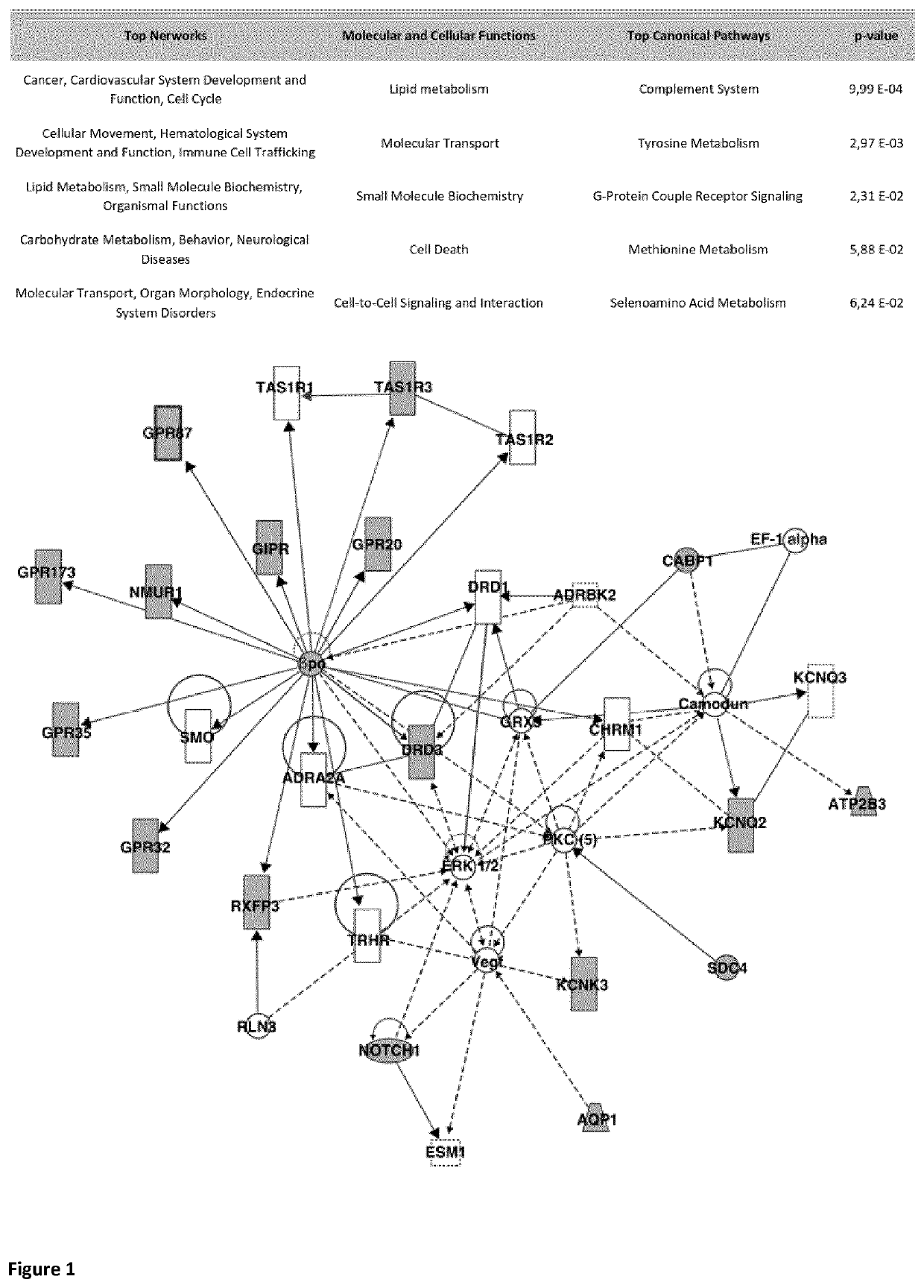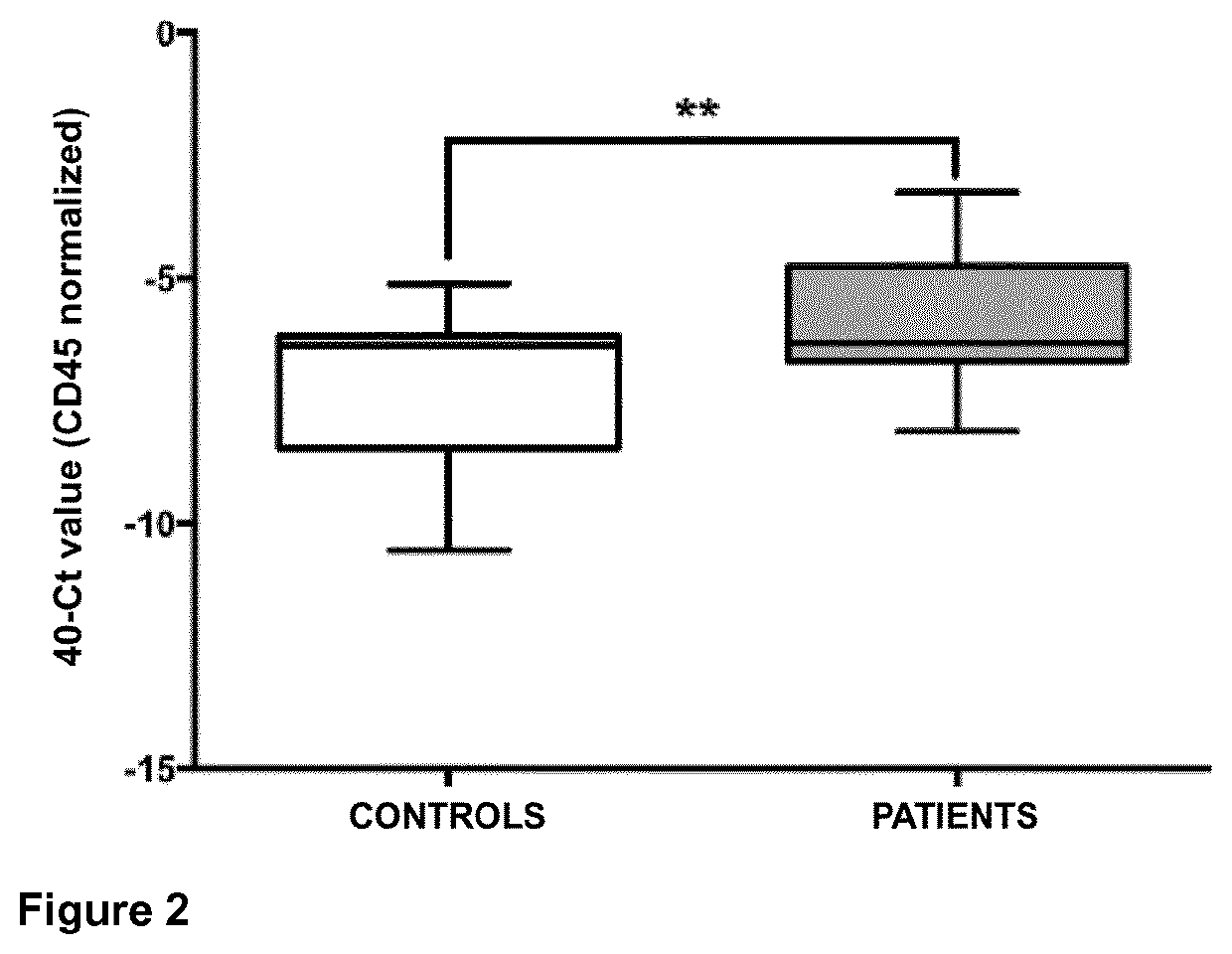Use of the tas1r3 protein as a marker for therapeutic, diagnostic, and/or prognostic purposes for tumors that express said protein
a technology of tas1r3 and tas1r3, which is applied in the field of tas1r3 protein, can solve the problems of difficult to achieve total cell destruction in the case of solid tumors, the most prevalent form of human cancer is still resistant, and the difficulty of most chemotherapeutic agents to achieve the effect of total cell destruction
- Summary
- Abstract
- Description
- Claims
- Application Information
AI Technical Summary
Benefits of technology
Problems solved by technology
Method used
Image
Examples
example 1
Expression of TAS1R3 Receptor in Tumor Cells
[0088]The analysis of the gene expression of the TAS1R3 receptor in CTCs (circulating tumor cells) of patients with metastatic lung cancer was performed from peripheral blood samples (patients=10, controls n=4), using magnetic particles for their isolation (EpCAM-based CELLection™ Epithelial Enrich Dynabeads® kit), following the diagram shown in FIG. 13. After extracting the RNA from the samples, they were hybridized in gene expression arrays. The signal was captured and processed in order to obtain a list of differentially expressed genes in patients with respect to the controls, among which were the TAS1R3 receptor. In summary, the total RNA of CTCs was amplified, the complementary DNA was hybridized in gene expression microarrays (Agilent) and the raw data were processed giving rise to 2,392 points, (7.01%) that met the criteria of quality. The average signal was 60,889 units, with 76,597 and 16,979 units for the patient and control gro...
example 2
Expression of TAS1R3 in Culture Media with Different Levels of Glucose Concentration
[0095]The expression of TAS1R3 in the colon line SW620 varies depending on the glucose content in the culture medium (high levels of glucose give rise to a lower expression, in relation to that observed in FIG. 6A for cells cultured in low content of glucose). This result, additionally, we have confirmed by western blot (FIG. 6B). Moreover, as seen in FIG. 6, receptor expression increases when SW620 colon cells are grown in the absence of glucose, which relates the expression of this receptor to cellular metabolism.
[0096]Cell proliferation studies were carried out in SW620 cells, FIG. 7A, cultured in medium with high and low glucose concentration. The cells were trypsinized and plated the same number of cells in order to count them at times 0, 24, 72, 96 and 168 hours, using for this the Neubauer chamber, after trypsinization thereof. In an analogous manner, cell proliferation studies were carried ou...
example 3
TAS1R3 as a Target for the Development of New Anti-Tumor Therapies
[0097]The presence of lactisole in the culture medium, a ligand of the TAS1R3 receptor, causes an increase in the expression of the receptor under study (FIG. 8A). Although at higher concentrations, the presence of ligand interferes with cell proliferation (FIG. 8B), a fact that we have related to the induction of cellular senescence (FIG. 8D). In addition, we have also seen by western blot that the presence of ligands of TAS1R3 such as lactisole or glucose (HG) in the culture medium of SW620, activates pathways related to tumor progression, such as p-ERK, p-AKT or IGF-IR (FIG. 8E). It was also determined how other ligands for TAS1R3, a peptide derived from brazzein and cyclamate, also interfere with proliferation, to a greater or lesser extent depending on the concentration and each molecule (FIG. 8F).
[0098]To determine whether after cell incubation with the ligand cell senescence is induced, 500,000 cells of the SW6...
PUM
| Property | Measurement | Unit |
|---|---|---|
| concentrations | aaaaa | aaaaa |
| concentration | aaaaa | aaaaa |
| concentrations | aaaaa | aaaaa |
Abstract
Description
Claims
Application Information
 Login to View More
Login to View More - R&D
- Intellectual Property
- Life Sciences
- Materials
- Tech Scout
- Unparalleled Data Quality
- Higher Quality Content
- 60% Fewer Hallucinations
Browse by: Latest US Patents, China's latest patents, Technical Efficacy Thesaurus, Application Domain, Technology Topic, Popular Technical Reports.
© 2025 PatSnap. All rights reserved.Legal|Privacy policy|Modern Slavery Act Transparency Statement|Sitemap|About US| Contact US: help@patsnap.com



